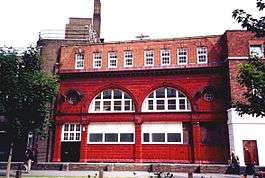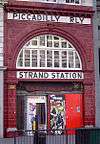Brompton Road tube station
| Brompton Road | |
|---|---|
|
Surviving fragment of Brompton Road tube station frontage, 2000 | |
 Brompton Road Location of Brompton Road in Central London | |
| Location | Brompton |
| Local authority | Kensington and Chelsea |
| Grid reference | TQ272791 |
| Number of platforms | 2 |
| Railway companies | |
| Original company | Great Northern, Piccadilly and Brompton Railway |
| Key dates | |
| 15 December 1906 | Station opened |
| 29 July 1934 | Station closed |
| Replaced by | None |
| Other information | |
| Lists of stations | |
| WGS84 | 51°29′50″N 0°10′08″W / 51.4971°N 0.1689°WCoordinates: 51°29′50″N 0°10′08″W / 51.4971°N 0.1689°W |
|
| |
Brompton Road is a disused station on the Piccadilly line of the London Underground. It is located between Knightsbridge and South Kensington stations.
It was closed in 1934, nearly 28 years after being opened by the Great Northern, Piccadilly and Brompton Railway company. During the Second World War it was used as the command centre of the 26th (London) Anti-Aircraft Brigade.[1] In 2014, the owner of the site, the Ministry of Defence, sold it to an unknown investor who will convert the site into residential flats.[2]
History
Brompton Road was opened on 15 December 1906 by the Great Northern, Piccadilly and Brompton Railway (GNP&BR).[3] The station was located at the junction of Brompton Road and Cottage Place. Although it was conveniently situated for both the Brompton Oratory and the Victoria and Albert Museum, it saw little passenger usage and by October 1909 some services passed through without stopping.[4]


The station closed on 4 May 1926 due to the general strike and did not reopen until 4 October of that year with services initially only calling there on weekdays. Sunday services were restored on 2 January 1927.[4] As before, Brompton Road was little used, to the extent that two of its lifts were removed and relocated elsewhere and the ticket office was closed.[4]
When the adjacent Knightsbridge station was modernised with escalators replacing lifts, it was provided with a new southern entrance that was built closer to Brompton Road station, reducing its catchment area. When the new entrance for Knightsbridge opened on 30 July 1934, Brompton Road closed.[3]
Just prior to the outbreak of the Second World War, the street-level building together with the lift shafts and lower western passages were sold to the War Office for a sum of £22,000 for use by the 26th (London) Anti-Aircraft Brigade of the 1st Anti-Aircraft Division. During the War, it was the Royal Artillery's anti-aircraft operations room for central London. This use was discontinued in the 1950s. It was subsequently used as the town headquarters (THQ) of the University of London Air Squadron, the University of London Royal Naval Unit and 46F (Kensington) Squadron Air Training Corps.
Station building
Like the others on the GNP&BR, the station building was designed by Leslie Green. The surface building occupied an L-shaped site built on two adjacent sides of a public house which occupied the corner of Brompton Road and Cottage Place. The façades were of Green's standard red-glazed terracotta design with semi-circular arches at first floor level. The entrance and exits to the lifts were on Brompton Road with the Cottage Place elevation providing staff access. The Brompton Road elevation was demolished in 1972,[4] but the Cottage Place elevation remains, now partly incorporated into a larger building.
Although the platforms have long since been removed, their original location can be seen from passing trains by the brick walls that stand in their place. The original tiling remains on the tunnel walls, although soot and dirt now obscures them.
Future plans
The Old London Underground Company proposed turning the above-ground buildings into a restaurant and making the underground space available to the London Fire Brigade Museum.[5][6] As the buildings were also used by the government for war planning purposes during the Second World War, there were plans to open these up to the public.[7]
In July 2013, the Ministry of Defence announced the site was for sale, with an expected price of about £20 million.[8] The MoD's property surveyor said specialist developers could adapt the 28,000 square feet (2,600 m2) site but conceded that this would require "a lot of work".[9] In November 2013 the site was confirmed sold, to Dmytro Firtash, a billionaire businessman from Ukraine, for £50 million.[10] A February 2014 report indicated the sale price to be £53 million and that the property would probably be used for residential purposes.[11]
In popular culture
A 1928 comedy play by Jevan Brandon-Thomas was about a woman who lived near Brompton Road and felt that life was passing her by just as the non-stopping trains were, and so it was titled Passing Brompton Road. The London production starring Marie Tempest ran for 174 performances. (For a 1931 film adaptation, the title was changed to Her Reputation.)[12][13][14]
In 2008 another play used the station. Sailing By, by Anthony Chew, took place on the long-closed platform, where two people sit and talk while Death stalks them.[12][15]
References
- ↑ Cooper, Nick (2014). London Underground at War. Amberley Books. ISBN 978-1-4456-2201-9.
- ↑ "London's Brompton Road Tube station sold for £53m". BBC News. 28 February 2014. Retrieved 28 February 2014.
- 1 2 Rose, Douglas (1999). The London Underground, A Diagrammatic History. Douglas Rose/Capital Transport. ISBN 1-85414-219-4.
- 1 2 3 4 Connor, J.E. (2001) [1999]. "Brompton Road". London's Disused Underground Stations. Capital Transport. p. 48. ISBN 1-85414-250-X.
- ↑ "Tourist attraction plan for disused Tube stations". BBC. 7 September 2011. Archived from the original on 2011-09-08.
- ↑ Spillane, Chris (8 September 2011). "London Entrepreneur Sees Gold Mine in Unused Subway Stations". Bloomberg. Archived from the original on 2011-09-23.
- ↑ Bolton, Matt. "Reawakening the Underground". BBC Travel. BBC. Archived from the original on 2011-11-12.
- ↑ Farmer, Ben (29 July 2013). "MoD to sell WWII Tube station command bunker". The Daily Telegraph. London. Archived from the original on August 1, 2013.
- ↑ "London Underground: Brompton tube station up for sale". BBC News. 7 August 2013. Archived from the original on 2014-02-18.
- ↑ Watson, Leon (27 November 2013). "Mystery Ukrainian billionaire plans to turn 'ghost' tube station that was used by Winston Churchill into flats after buying it for £50million". Daily Mail. London. Archived from the original on 2013-11-28.
- ↑ "BBC News - London's Brompton Road Tube station sold for £53m". BBC. 2014-02-28. Retrieved 2014-02-28.
- 1 2 Davies, Adrian. "Brompton Road: Once upon a time...". Archived from the original on 2011-02-24.
- ↑ Connor, J.E. (October 1997). "Recalling Brompton Road" (PDF). The London Railway Record. 1 (13). Archived (PDF) from the original on 2011-03-02.
- ↑ "Her Reputation (1931)". IMDB. Archived from the original on 2005-03-09.
- ↑ "Archive 2008". The Byfleet Players. Archived from the original on 2011-05-16.
External links
| Wikimedia Commons has media related to Brompton Road tube station. |
- "Brompton Road Station - once upon a time". Brompton Road. Archived from the original on 2011-09-11.
- "Brompton Road". Disused stations. Subterranea Britannica. Archived from the original on 2000-08-17. (includes photos of station as it is today)
- London Transport Museum Photographic Archive Original station building shortly after opening
- Mansfield, Ian (5 August 2011). "Photos of the MoD side of the station taken in 2011". IanVisits. Archived from the original on 2011-09-29.
| Preceding station | Following station | |||
|---|---|---|---|---|
| Former Route | ||||
| Piccadilly line 1906-1934 | towards Cockfosters |
|||

